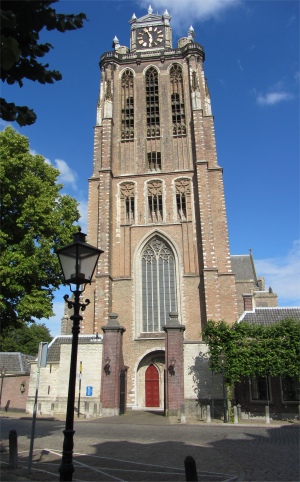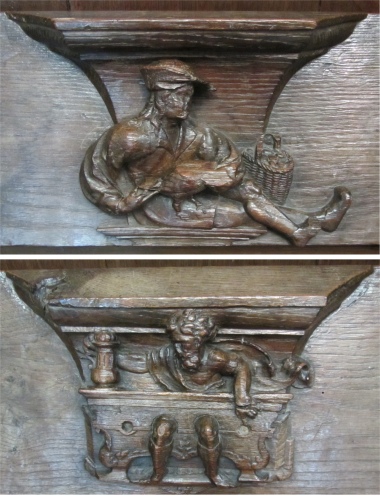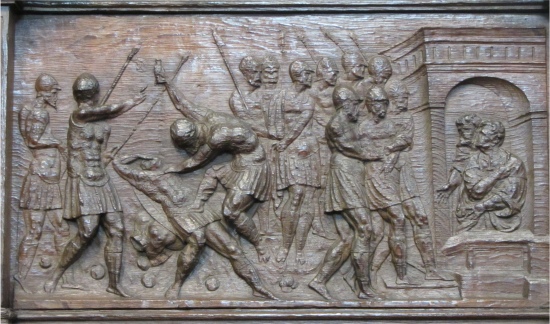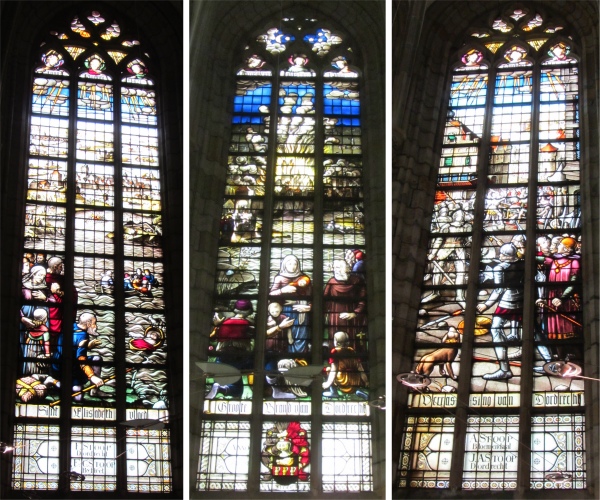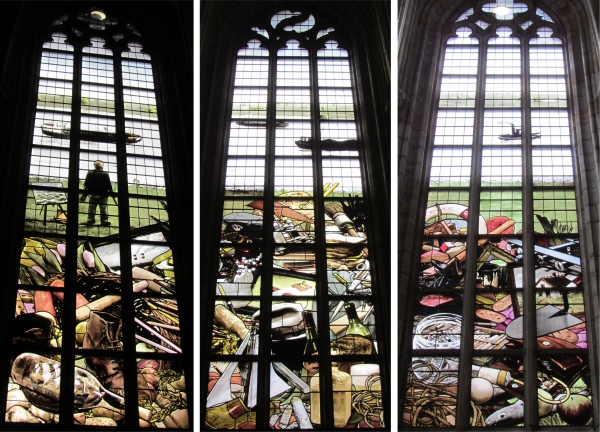After a warm drink to still the nerves we walked up Nieuwe Haven, created in 1410, to the house of Simon van Gijn, now a museum. This business man, lawyer and collector lived here from 1864 until his death in 1922. He left his house and most of his collections to the Old Dordrecht Society. His wish was for the collections to be made publicly accessible and for his house to be converted into a museum.
Van Gijn was born in Vlaardingen in 1836, and his family moved to Dordrecht in 1842, where Simon's father joined his father-in-law's banking firm. From a young age Simon took a keen interest in history, and was encouraged by his mother to start collecting historical prints. He also showed an interest in arts and crafts. After studying law in Leiden, van Gijn established himself as a lawyer in Dordrecht in 1863. That same year he followed his father as a banker in the family business. In 1864, he married and bought the house, and the couple created various period rooms. The collection included model ships, porcelain, glass, silver, furniture, prints and paintings, as well as antique toys in the attic. Domestic life was also reflected in the museum, with linen hanging on the washing line, the dinner table set with attractive crockery, and the copper pans gleaming in the kitchen.
I made some enquiries of one of the lady curators regarding some of the paintings, and was impressed with her English. "Your English is excellent," I commented, "Where did you learn it?"
"I learnt at school, but most was learnt from my husband who is Scottish. He refuses to speak Dutch, so that is the only language we can communicate in," she told me laughingly. She pointed out another artwork on a wall in one of the rooms, which looked like a bass relief sculpture and painting combined. The artist had a unique style, he would chew wall paper, and then sculpt it into the delicate shapes I could see. The maritime scene was impressive, a lot of patience had been taken and the artist was clearly gifted, but how on earth did he engage on that style in the first place?
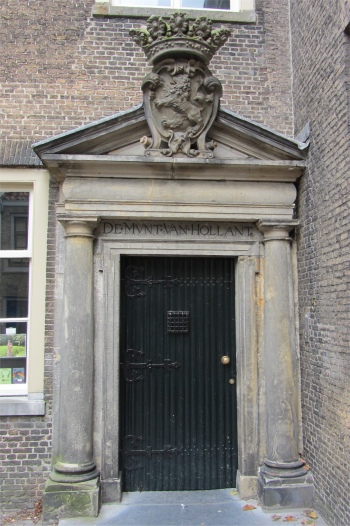
The Unassuming De Munt Entrance
|
The air was warming up now, and the black clouds had vaporised, so we took a leisurely stroll up to 't Vlak by the Dok Straatman, and then up by the Wolwevershaven, created in 1609. The Stokholm Warehouse stood high and proud with its gleaming red shutters. Just past it lay the Dordts Patriciershuis, a museum that allowed folk to experience how a Dordrecht patrician household lived at the end of the 18th century.
A pause at the Groothoofd was obligatory, what else could we do at this major confluence of three important waterways? After passing through the historic Groothoofdspoort, we walked down Wijnstraat, stopping to have a look at 't Zeepaert. Built around 1495, this was Dordrecht's oldest dwelling, and one of the oldest in the Netherlands. It had been home to a soap maker, a brewer and various merchants. Now it had reached the pinnacle of its career, the restored building was used for conferences. How sad I thought, and to look at it, I for one would never have guessed as to its age or history.
We crossed the Wijnhaven via the Nieuwebrug, admiring dwellings on either side of the bridge. On one side a garden overhung the Wijnhaven, and on the other, balconies of a small block of flats were adorned with three-dimensional gardens.
Just off Voorstraat we found De Munt. The sandstone Muntpoortje gate, dating form 1555, on the Voorstraat gave access to the Muntgebouw (the Mint). Here, from 1367 up to its closure in 1806, the coins for Holland and Zeeland were minted. The Holland coat of arms hung above the entrance of the main building.
Our hike naturally led us on to Het Hof (the Court) next. In the Middle Ages, Het Hof was the most important Augustinian monastery in the Northern Netherlands. What remained were the main building with the refectory, the sleeping quarters and the crypts. In 1572, an important meeting was held in Het Hof, participants being representatives of the cities of Holland that revolted against King Philip II of Spain. Their decision led to the independent Republic of the United Netherlands. While we were there, Het Hof was being renovated and restored before being reopened with a contemporary presentation of the history of Dordrecht, an exhibition hall and a reading room.
Lazily meandering, we passed through the shopping district, and gazed at the almshouses between Bagijnhof and Vieisestraat. These were built for poor women around several courtyards, dating from 1755. They were now occupied by both men and women.
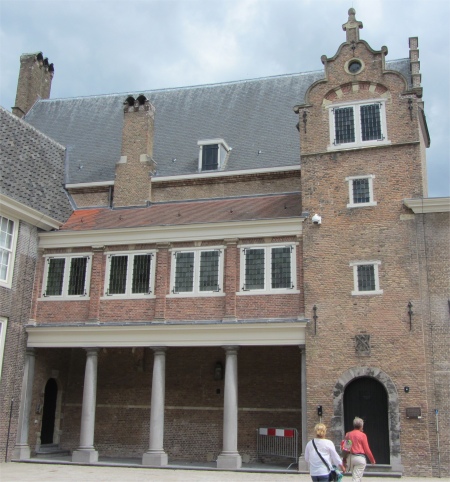
Het Hof
|
Our objective was reached, the train station, where we checked up on the train times to Gorinchem. They were very frequent and cheap. This completely put the idea of taking the boat up there into touch, three bridges would have had to be negotiated in each direction rendering time consuming journeys.
Making our way back to the boat, we stopped off for a drink at a cafe by the Spuihaven. Meryl wanted an Earl Grey tea. "No problem," replied the waitress. In no time at all she received a cup of hot water and a stick shaped packet that contained the tea leaves. The packet was perforated, but upon stirring the "stick" in the hot water, the herbal infusion was instigated. The result was a perfect cup of Earl Grey tea as far as Meryl was concerned.
Back on board
Duonita, after obtaining provisions and loading washing machines, Rex fell into conversation with the Dutch chap on the adjacent boat. The guy had an excellent book on the tidal flows within the Schelde and connecting channels, which he lent us. This enabled Rex to plan an efficient passage for later to the Haringvliet using tidal flows to our advantage. The fellow went walkabout, so Rex deposited his book back on board with a thank you note in his impeccable Dutch. Smart cookie, not only can he speak the language, he can write it too!
After a delicious meal on board, we chilled out for a while listening to some of Rex's music from the 60s to the 00s, bliss. Rex was frantically dancing around the boat with his air guitar, a cool mover. The lad has an in-depth knowledge of music from this era, the bands and characters. As for me, I have my favourite songs, but am totally useless when it comes to all the nitty gritty details of who, what, where and when. Life is too short.
Suddenly there was a tap on the side of the boat; was somebody wanting to complain about the din we were making? Rex quickly killed the music and climbed outside. It was the chap from the adjacent boat, he came to give Rex the book on tidal flows that he had lent him earlier. The kindness of strangers.
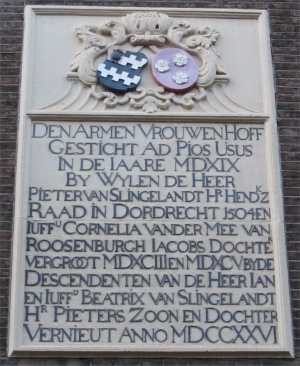
Almshouses Plaque (The Poor Women Yard)
|
During our trip together, I had often thought long and hard about my travelling companions. I was concerned that they should have some quality time together, three's a crowd, two's company principle so to speak. I felt strongly that they should have their "us" quality time, but it is a difficult subject to broach without sounding harsh as if I were shunning their company. But I was determined that tonight they should go off and do their own thing. I am more than capable of venturing out on my own.
We went off on our separate ways. I picked up the strains of distant music and sought it out. It emanated from a long narrow funfair on the Spuiboulevard. Apart from the language difference, the fair could have been anywhere in Britain. I didn't linger, but instead took a hike up the long Voorstraat which brought me up to the northern end of the city. The neighbourhood of the Grote Markt (town square) had been completely destroyed and replaced by soulless social housing. I came across gangs of youths kicking footballs about, but I didn't feel threatened. Keeping to this side of town I marched north through more social housing up to the Nieuwekerksplein, containing a large unattractive church and nothing else, and sitting at the top of the island was Otto Dickeplein, near to where the Riedijkshaven, Wantij and Beneden Merwede all met. There was no evidence of a plain, just a complex of flats. This was the other side of the island city that wasn't mentioned in the guide books. Yet people needed somewhere to live, and the area was clean with no evidence of trouble.
By the time I returned to the boat, Rex and Meryl had already turned in. They were still awake, so we shared our stories before settling down to slumbers.
